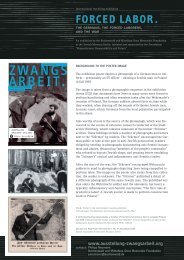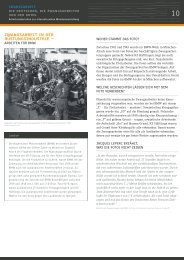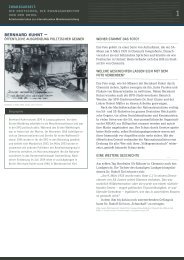FORCED LABOR . - Ausstellung Zwangsarbeit
FORCED LABOR . - Ausstellung Zwangsarbeit
FORCED LABOR . - Ausstellung Zwangsarbeit
- No tags were found...
You also want an ePaper? Increase the reach of your titles
YUMPU automatically turns print PDFs into web optimized ePapers that Google loves.
International travelling exhibitionforced labor .the germans, the forced laborers,and the warAn exhibition by the Buchenwald and Mittelbau-Dora Memorials Foundationat the Jewish Museum Berlin, initiated and sponsored by the Foundation“Remembrance, Responsibility and Future”Companion volume to the exhibitionForced labor. The germans, the forced laborers,and the warthe germans, the forced laborers,and the warPublished by Volkhard Knigge, Rikola-Gunnar Lüttgenauand Jens-Christian Wagner on behalf of the Buchenwaldand Mittelbau-Dora Memorials FoundationF o r c e d l a b o r .the germans, the forced laborers, and the warA total of 256 pages:– 180 pages presentation of the exhibition– 65 pages systematizing scholarly contributions– 188 illustrationsFormat: 20.5 x 27.5 cm– Paperback with thread stitchingPrice of sale: 19,80 euroISBN German edition: 978-3-935598-17-0ISBN English edition: 978-3-935598-18-7ISBN Russian edition: 978-3-935598-20-0The exhibition tells the whole story of National Socialist forced laborand its post-1945 consequences for the first time. It shows that forcedlabor was a mass phenomenon: during World War II, a workforce oftwenty million performed involuntary labor for National SocialistGermany almost all over Europe. It moreover sheds light on the factthat, from the beginning, forced labor was an integral part of the NSstate’s racist social order: the propagated “people’s community” andforced labor performed by the outsiders were two sides of the samecoin.This volume documents the main aspects of the exhibition andpresents numerous hitherto unknown historical photos and documents.Supplementary systematizing scholarly contributions by suchnotable authors as Dieter Pohl, Dietmar Süß and Constantin Goschleroffer more in-depth insights into research on the history of NationalSocialist forced labor.The accompanying book (in German and English) can also be purchasedat the Buchenwald Memorial’s specialized bookshop on thehistory of National Socialism, the concentration camps and thespecial camps.phone: + 49 (0) 3643 430 151mail: buchhandlung@buchenwald.deTo order review copies of the accompanying book, please contactthe Press and Publicity Department (Abteilung Presse- undÖffentlichkeitsarbeit).mail: pneumann@buchenwald.dewww.ausstellung-zwangsarbeit.orgcontact: Philipp NeumannBuchenwald and Mittelbau-Dora Memorials Foundationpneumann@buchenwald.de
Buchenwald and Mittelbau-Dora Memorials FoundationDirektion – Haus 2, 99427 WeimarPhone +49 (0)3643 430 130Fax +49 (0)3643 430 100Internet www.ausstellung-zwangsarbeit.orgThe European Dimension of Forced Labor in the National Socialist Era► What is National Socialist forced labor?Very different groups of persons are referred to indiscriminately as forced laborers. Yet the formalframework conditions according to which people were forced to perform labor in the NationalSocialist era varied greatly. The degree of force used and the forced laborers’ living conditions couldalso be very different.On the one hand, the objectives pursued with forced labor as well as the treatment to which forcedlaborers were subjected depended on the status assigned to the respective groups of persons withinthe National Socialist racial hierarchy: There were fundamental differences depending on whether itwas Jews or Sinti who were being enlisted for forced labor (two groups whose right to existence wasdenied by Nazi ideology), slave workers (whom the National Socialists considered racially inferiorand who were accordingly deprived of their rights), or Northern and Western Europeans (who wereassigned a relatively high rung on the Nazi racial-hierarchical ladder).On the other hand, the forced laborer category (foreign workers, prisoners of war, inmates of workeducation camps [“Arbeitserziehungslager”], camp inmates, ghetto inhabitants, etc.) had a decisiveinfluence on the laborers’ living conditions and chances of survival. Jewish forced laborers,concentration camp inmates and Soviet prisoners of war suffered from the severest living andworking conditions.DefinitionAn employment relationship can be referred to as forced labor in all cases in which the laborer wasforced to work against his/her will with coercive measures of a non-material nature, and in which thelaborer had little or no influence on his/her working and living conditions (choice of workplace andliving quarters, remuneration, holiday, etc.). National Socialist forced labor usually went hand inhand with deportation.► Who had to perform forced labor in the German Reich?Foreign workersCivilian workers (male and female) who had been brought to Germany from the occupied territories,and who were not permitted to leave their place of work or residence. They were usually givenaccommodations in “Gemeinschaftslager” (“communal camps”). Within this group, the livingconditions were the worst for Polish workers and so-called “Ostarbeiter” (“Eastern workers” = Sovietcivilian workers). The total number of “Fremdarbeiter” (“foreign workers”) is estimated at 8.4million men and women, among them almost 3 million from Belarus, Ukraine and Russia.Prisoners of warContrary to the conditions of the 1929 Geneva Convention relative to the treatment of prisoners ofwar, the Wehrmacht forced particularly Soviet and Italian prisoners of war to work in the armamentindustry. The prisoners of war assigned to forced labor in the armament industry and agriculturenumbered altogether 4.6 million men. The majority of the prisoners of war came from the SovietUnion (almost 2 million), France (almost 1.3 million) and Italy (500,000).1
Buchenwald and Mittelbau-Dora Memorials FoundationDirektion – Haus 2, 99427 WeimarPhone +49 (0)3643 430 130Fax +49 (0)3643 430 100Internet www.ausstellung-zwangsarbeit.orgCamp inmatesFrom 1943 onward, nearly all concentration camp inmates were put to work in the armamentindustry against their will. The category of concentration camp inmates made to perform forced labornumbers approximately one million men and women. Most of them came from the Soviet Union andPoland.“Work Jews”Beginning in 1938, the Jewish populations throughout the areas under German control werecompelled to perform forced labor. These persons were given accommodations in forced labor campsand ghettos. Nearly all of them were later murdered in the extermination camps. A total ofapproximately 110,000 Jews and Jewesses were assigned to forced labor within Reich territoryoutside the concentration camps. The number was much higher outside the Reich borders.Sinti and RomaFrom the end of the 1930s onwards, Sinti and Roma in the German Reich were robbed of theirfreedom of movement and recruited for forced labor. After the war had begun, Sinti and Roma had toperform forced labor primarily in the occupied areas in the East. Many did not survive the ordeal.Prison convictsThe inmates of prisons and prison camps were also forced to perform labor (primarily in constructionand amelioration measures). The majority of these persons were of German nationality. The Germanprison convicts recruited for forced labor presumably numbered about 200,000 in total.► Misery in numbersDuring World War II, altogether more than 13 million persons had to perform forced labor in the“Pan-German Reich” (i.e. Germany, Austria and the annexed areas of the neighbouring countries,above all Poland and the present-day Czech Republic). The discrepancy between this and the sum ofthe above-cited numbers results from the fact that many persons belonged to more than one categoryin the course of their forced labor career. Prisoners of war, for example, could be awarded civilian“foreign worker” status, and the Gestapo committed numerous such workers to concentration camps.Owing to the lack of source material, the number of persons performing forced labor outside Reichborders in German-occupied or German-controlled areas can only be estimated. It can be assumedthat they numbered at least 7 million. The total number of men, women and children recruited forforced labor for Nazi Germany both within and outside the German Reich accordingly exceeds 20million.The number of deaths among the forced laborers can be estimated only for the territory of theGerman Reich. Altogether, some 2.7 million forced laborers died between 1933 and 1945 as aconsequence of debilitating working conditions, hunger, murder, inadequate hygienic conditions, alack of medical care, and abuse by German overseers. Concentration camp inmates and Sovietprisoners of war accounted for the largest proportion of the victims.2






